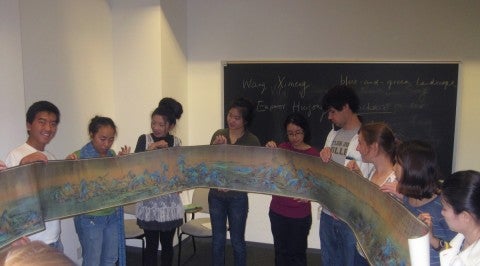The Department of Art History encourages interdisciplinary coursework and research through collaborative links between the department and its affiliated faculty who serve as curators in Houston or who teach visual and material culture in other departments at Rice. Our program also benefits from the rich visual culture of Houston. We have special relationships with the Museum of Fine Arts, Houston, The Menil Collection and Asia Society Texas Center by way of fellowships, research projects and courses.
The area around Rice is home to many more museums including the The Printing Museum, Houston Museum of Natural Science, which includes a permanent loan-based exhibition in Egyptian art, the Houston Center for Contemporary Craft, Holocaust Museum Houston and over a dozen other arts and cultural museums.
The Museum of Fine Arts, Houston contains an encyclopedic collection of global art from antiquity to the present that includes Bayou Bend, with its collection of American decorative art and painting; the Blaffer Collection of Old Master paintings and prints; the Latin American collections and the affiliated International Center for the Art of the Americas; and an outstanding collection of modern and contemporary works.
Directly across the street from the MFAH is the Contemporary Arts Museum, Houston, a non-collecting museum that first opened in 1948. Reflecting the full diversity of contemporary art practice, recent one-person shows have included exhibitions by Kiki Smith, Andrea Zittel, Shirin Neshat, and William Kentridge, among many others, and group exhibitions that include, “Double Consciousness: Black Conceptual Art Since 1970,” “Fade In: New Film and Video,” and “The Old, Weird America.” CAMH also hosts a wide range of cultural events and artist talks.
The Menil Collection, which was designed by Renzo Piano, exhibits the diverse private art collection of John & Dominique de Menil. The collection of 15,000 objects features strengths in the European avant-garde, American post-war modernism, and African art, as well as the arts of Oceania and the Pacific Northwest. The renowned collection has important examples of modern painting and sculpture, as well as significant holdings in Antiquity, Byzantine and Medieval, and 20th Century Art. The Rothko Chapel is a short walk from the museum building. In 1995 the Menil Collection opened the Cy Twombly Gallery, and in 2015, broke ground on a Drawing Institute and Study Center dedicated to the research and display of drawings.
The Texas branch of the international Asia Society is located in the Houston Museum District. Asia Society has eleven locations around the world; the society describes itself as "the leading educational organization promoting mutual understanding and strengthening partnerships among the peoples, leaders, and institutions of Asia and the United States." Asia Society Texas Center focuses its global mission by way of a local focus that engages the diversity of Houston with "innovative programs in arts and culture, business and policy, education, and community outreach." Their new building, designed by Yoshio Taniguchi, opened in 2013.
The Moody Center for the Arts is an internationally focused arts institution on the Rice University campus, built as a free public platform for creating collaborative works of all kinds and for presenting innovative, transdisciplinary experiences to the public and the university community.
Project Row Houses occupies Houston's Historic Third Ward, one of the city's oldest African-American neighborhoods, and aims to encourage artists to build a creative environment that enriches lives and cultural identities through mentorship and public art opportunities. They engage with the Third Ward residents and work alongside them to directly address changes that affect marginalized communities by developing opportunities for artists, small businesses, and under resourced residents. The site encompasses five city blocks and houses 39 structures that serve as home base to a variety of community enriching initiatives, art programs, and neighborhood development activities.

